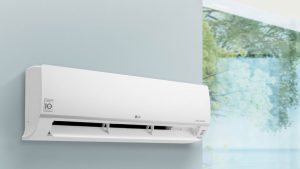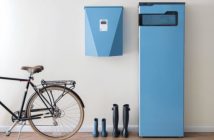As temperatures drop, you may find yourself shutting all windows and doors in an attempt to stay warm inside. While it may feel cosy being shielded from the cold, a lack of ventilation carries many health risks.
With more than 91% of the world’s population living in places where air pollution levels exceed international guideline limits, breathing cleaner indoor air is more important than ever. Poor air quality in our homes can have a significant effect on our health and general wellbeing. Gases and chemicals like carbon monoxide, nitrogen dioxide, and volatile organic compounds (VOCs) find their way into our air from paints, cleaning products, glue, pesticides, hairspray, perfumes, nail polish, permanent markers, and even fabrics and upholstery.
If anyone in your home suffers from allergies, is constantly battling a sinus infection, or struggles with asthma, these simple tips will help improve the air quality in your living space. And create a healthier environment for the whole family.
PriceCheck tip: Smart homes are on the rise, and automating your house’s functions is a great way to streamline your day-to-day house management. Check out the smart home trends of 2022 for more information.

Health risks of poor indoor air quality
The WHO (World Health Organisation) estimates that poor indoor air is responsible for nearly 3% of the global burden of disease. Keeping your windows and doors shut can carry these health dangers:
• Lack of ventilation increases the amount of allergy-inducing dust mites, pet dander, and mould spores circulating through your house.
• No flow of fresh air from the outside means that allergens, bacteria and other microbes stay trapped inside – these pollutants are up to five times more concentrated inside than outside.
• Asthma flare-ups and allergies are likely to increase through the colder months if you always keep doors and windows shut.
• Higher concentration of CO2 levels are accumulated indoors with closed windows and more time spent inside – too much CO2 exposure causes headaches, restlessness, drowsiness, poor sleep, respiratory issues, cardiovascular irregularities, inability to concentrate and more!
• Indoor air pollution is linked to an increased risk of pneumonia, bronchitis and other respiratory concerns.
Want to improve the air quality of your home this winter? Check out these 5 tips for better indoor air quality in the cold winter months ahead:

Let stale air out
Most energy-efficient homes are built airtight, which often results in impressive energy savings, but can mean your home doesn’t get enough fresh air. Make sure you have plenty of fresh air circulating through your home by opening windows and doors whenever possible. This will also help keep dampness and mould at bay.
Make sure a window is often, or always, open – Keep a window open, even if it’s only slightly cracked open. This is the easiest and most cost-effective way of cleaning indoor air.
Play it cool
High-quality air is undeniably essential for everyone. So it might be time to invest in a premium air-conditioning system for your home that will purify the air in your home and prevent harmful particles and allergens from passing through.
With its unique Ionizer, the LG Artcool air conditioner does just that by releasing over 3 million ions that work actively to remove harmful substances and odours from indoor air. More so, the Micro Dust Filter captures and eliminates damaging micro-particles, including bacteria and dust, for even fresher, cleaner air. The best part is that all this hard work won’t impact your electricity bill. The system boasts up to 70% energy saving when compared to conventional on/off models with its innovative inverter compressor technology.
Keep a handle on humidity
Depending on where you live, controlling indoor humidity is not always easy. An air purifier, humidifier or diffuser may offer a solution that results in improved air quality – and better sleep!
Because pollen and mould counts tend to be higher in spring and summer, using a humidifier in your home may help prevent sinuses from becoming inflamed. Be sure to use distilled or demineralised water in your humidifier and change it regularly. Running an air conditioner – especially during the summer months – will also help control humidity.

Control dirt and dust
As the most common indoor allergen, dust contains a variety of airborne irritants that can be harmful to people with allergies. Vacuuming regularly is key to controlling allergy and asthma triggers – especially when it comes to eliminating dust mites and pet fur.
Make your front door the first line of defence by putting down an easy-to-clean doormat and leaving shoes at the door. This will prevent dust particles from going any further. Keep in mind that dust and allergens settle on hard surfaces – as well as carpeted floors – and will get stirred up into the air when there’s activity. Positioning doormats and rugs in high-traffic places will act as filters, trapping dust until it’s time to haul out the vacuum. Use a vacuum cleaner with a high-efficiency particulate absorbing (HEPA) filter as it will stop dust, pollen, and other contaminants from recirculating in the air.
Clean green
When buying cleaning products, always check the labels. Where possible, opt for environmentally safe and fragrance-free cleaning products, as most store-bought fragrances, air fresheners, and perfumes can impact chemical pollution in your home. Although they make your home smell heavenly, petroleum-based wax candles can also contribute to unhealthy air. Rather go for artisanal chemical-free room fresheners instead.
Applying these handy tips will result in an immediate improvement in indoor air quality, making it possible for you to breathe easier knowing the air in your home is safe and clean.

Invest in house plants
Keep houseplants in every room. Indoor houseplants are a brilliant (and attractive) way to purify the air, as these plants naturally filter the air and improve air quality. Lilies, ferns, chrysanthemums, snake plants and palms are some of the best indoor plants for filtering the air, plus they make for beautiful home décor. If you have pets inside the home, it is important to choose indoor plants that are non-toxic to animals.
Dust regularly
Dust is an irritant that aggravates symptoms of allergies, asthma, irritations of the eyes, coughing, and various other respiratory issues. You’ll be surprised to learn how much rugs, cushions, couches and other surfaces retain dust particles and mites. To improve air quality, dust out your home regularly; take cushions, bedding and rugs outside to bang out the dust outside your home. Vacuum/sweep carpets, corners and other surfaces and keep surfaces clean of clutter – as clutter makes perfect environments to collect dust – and wipe them clean to pick up all remaining particles.



